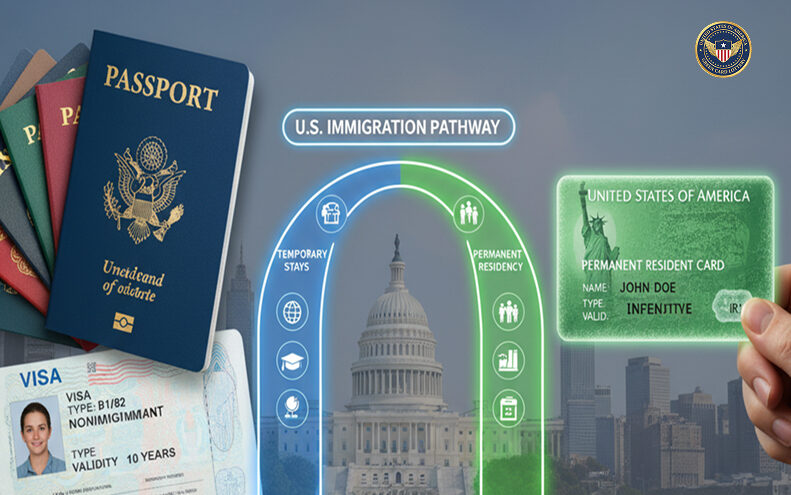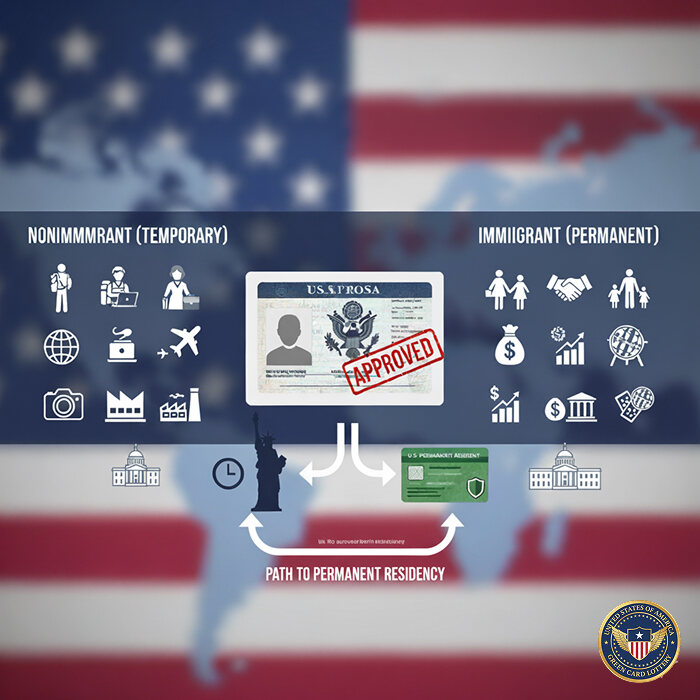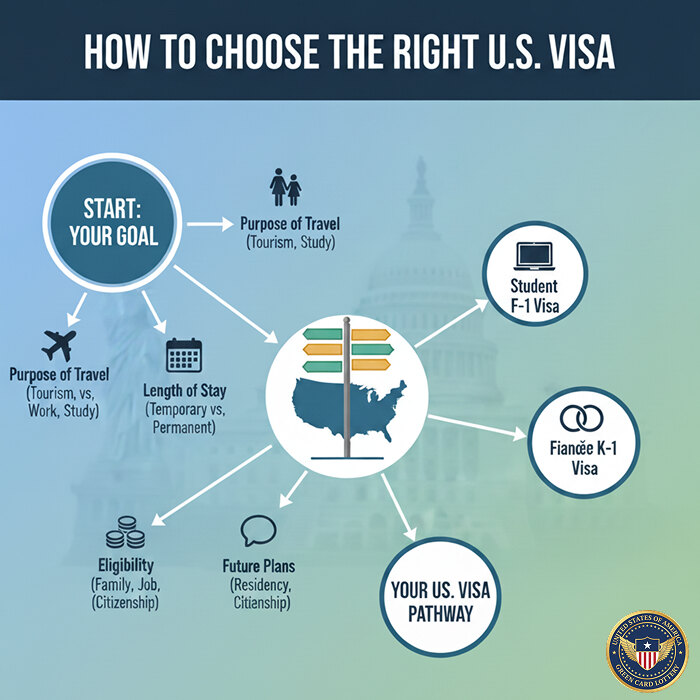The United States has one of the most complex immigration systems in the world, offering a range of US visa types for both temporary and permanent stays. Whether you are visiting for tourism, studying at a U.S. university, accepting a job offer, reuniting with family, or applying for permanent residency, there is a specific visa designed for your situation.
Immigrant visas are for individuals who wish to reside permanently in the United States. Once approved, applicants become Lawful Permanent Residents (LPRs) and receive a Green Card.
What are the main types of U.S. visas?
The U.S. has two main visa categories: nonimmigrant visas for temporary stays (such as tourism, business, study, or work) and immigrant visas for permanent residency (leading to a Green Card). Each category has multiple subtypes, depending on your reason for travel. Choosing the right type is essential, as it determines your legal rights and length of stay in the U.S.
What is the difference between a nonimmigrant visa and an immigrant visa?
A nonimmigrant visa allows you to enter the U.S. for a limited period and specific purpose, such as studying (F-1) or tourism (B-2). An immigrant visa, on the other hand, is for individuals planning to live permanently in the U.S. and often leads to a Green Card, which in turn can eventually result in U.S. citizenship. The key difference lies in intention—whether it is a temporary visit or a permanent move.
What is the Diversity Visa Lottery?
The Diversity Visa (DV) Lottery is a U.S. immigration program that randomly selects applicants from countries with historically low rates of immigration to the U.S. Each year, approximately 50,000 visas are available. Winners get the opportunity to apply for a Green Card, provided they meet education or work experience requirements. The lottery helps promote diversity among U.S. immigrants.
Who can apply for a U.S. visa?
Almost anyone can apply, but eligibility depends on your country of citizenship, the purpose of your travel, and the category of visa. For example, Canadian and Mexican professionals may qualify for TN visas under NAFTA/USMCA. At the same time, international students apply for F or M visas. Immigrant visa eligibility often depends on family ties, employment, or the DV lottery program.
How do I apply for a U.S. visa?
The process begins by completing the appropriate application form (DS-160 for nonimmigrant or DS-260 for immigrant visas), paying the fee, and scheduling an interview at a U.S. consulate. Applicants must provide supporting documents such as passports, financial statements, invitation letters, or work approvals. For immigrant visas, sponsorship from a family member or employer may be required.
How long does it take to get a U.S. visa?
Processing times vary by visa category and country of application. Tourist visas may be processed within a few weeks, while student or work visas can take several months. Immigrant visas, such as family- or employment-based visas, can take years due to annual quotas and lengthy backlogs. Always apply early and track your case on official U.S. government portals.
What are the fees for U.S. visas?
Fees depend on the visa category. For example, most nonimmigrant visa applications cost around $185. In contrast, immigrant visas are more expensive due to additional processing and medical exam fees. Additionally, certain visas, such as the EB-5 investor visa, require a significant financial investment. Always confirm the latest fee schedule on the U.S. Department of State website.
Can I work in the U.S. on a nonimmigrant visa?
Yes, but only if your visa permits it. For example, H-1B visas allow employment in specialty occupations. In contrast, F-1 student visas allow limited on-campus work and Optional Practical Training (OPT). However, a B-1/B-2 tourist visa does not permit employment. Unauthorized work can result in visa cancellation or deportation.
Can I switch from a nonimmigrant visa to an immigrant visa?
In many cases, yes. For example, a student on an F-1 visa may later qualify for an employment-based Green Card, or a temporary worker may become a permanent resident through sponsorship. The process is called adjustment of status and involves USCIS approval. Not all visas allow this transition, so eligibility should be checked in advance.
What happens if my U.S. visa is denied?
A visa denial can occur due to missing documents, insufficient financial proof, prior immigration violations, or ineligibility under U.S. immigration law. You may reapply if your circumstances change or if you appeal under certain conditions. Consular officers usually provide a reason for denial under the relevant section of U.S. law (e.g., 214(b) for lack of ties to home country).
Can I travel to the U.S. without a visa?
Yes, if you are from a Visa Waiver Program (VWP) country. In that case, you can visit the U.S. for tourism or business purposes for up to 90 days without a visa, provided you have an ESTA authorization. However, this does not apply to work, study, or permanent residency. Citizens from non-VWP countries must obtain the appropriate visa before traveling.
Do U.S. visas guarantee entry into the United States?
No. A visa allows you to travel to a U.S. port of entry. Still, the final decision rests with Customs and Border Protection (CBP) officers. They may deny entry if you don’t meet the requirements or pose a security concern. Always carry proper documentation and be prepared to explain the purpose of your visit.
Can family members apply together for U.S. visas?
Yes. Dependents such as spouses and children can often apply for derivative visas. For example, the spouse and children of an H-1B worker are eligible to apply for H-4 visas. Similarly, F-1 students may bring dependents under F-2 visas. For immigrant visas, family members are often included in sponsorship applications.
What documents are usually required for a U.S. visa application?
Common documents include a valid passport, a completed application form, a recent passport-size photo, a visa fee receipt, invitation/sponsorship letters, and proof of financial ability. For immigrant visas, additional documents, such as birth certificates, marriage certificates, and police clearance certificates, are required. Each visa class may have unique document requirements.
How long can I stay in the U.S. on a visa?
The duration of your stay depends on the type of visa you hold. For example, tourists on B-2 visas are typically allowed to stay for up to 6 months, while students may remain for the duration of their academic program. Immigrant visas, once approved, allow permanent residency. Overstaying can result in fines, bans, or future visa denials.






